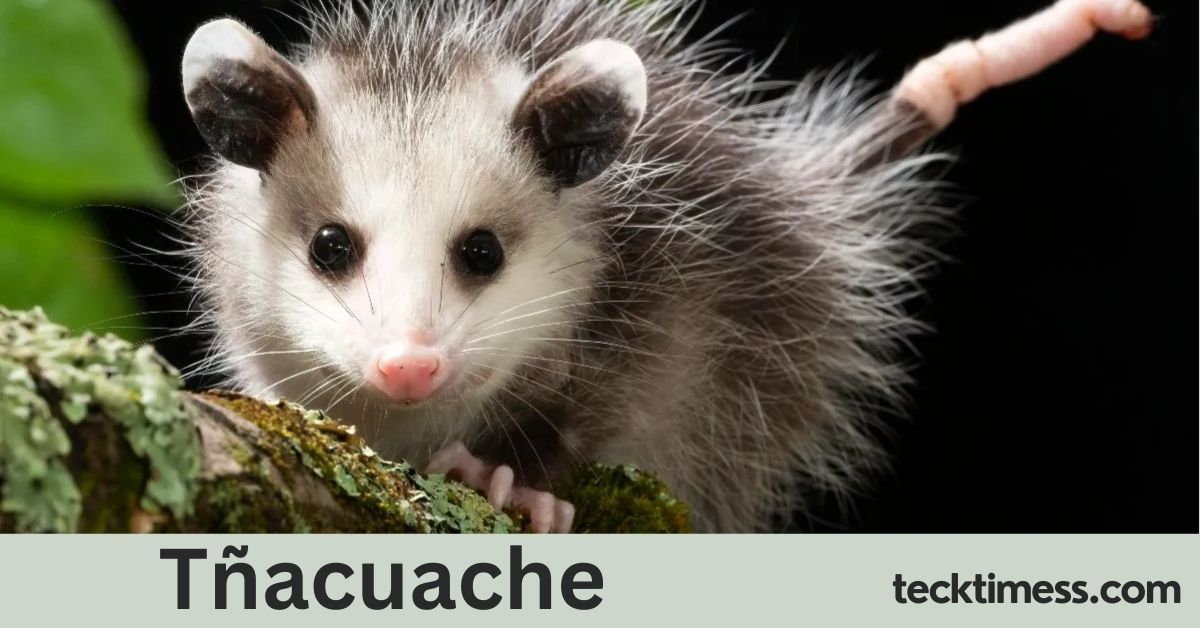Have you ever heard of the “tñacuache”? If you’re in the U.S., it might be an unfamiliar term, but it’s a fascinating creature worth learning about. Tñacuaches belong to the Didelphidae family, which includes over 100 species of opossum. These mammals have been around for millions of years, making them one of the oldest surviving mammalian species. In this article, we’ll explore what makes tñacuaches so interesting and unique, from their biology to their role in ecosystems, and why they have captured the imagination of people worldwide.
What is a Tñacuache?
A tñacuache is essentially a type of opossum, a small to medium-sized mammal found mainly in the Americas. These creatures have long tails, sharp claws, and an almost prehistoric look, with their pointed noses and sharp teeth. While “tñacuache” may be less commonly used in English-speaking regions, the term is often used in Latin America and refers to the same family of marsupials.
The Didelphidae Family: Ancient Survivors
Tñacuaches belong to the Didelphidae family, a group of marsupials that have survived since the age of dinosaurs. This ancient lineage makes tñacuaches and their relatives some of the oldest living mammals on the planet. They are often considered living fossils due to their long evolutionary history.
Marsupials are mammals characterized by giving birth to relatively underdeveloped young, which then continue to grow in a pouch on the mother’s belly. Opossums, including the tñacuache, are no different, and their young spend weeks or even months inside the pouch before emerging to explore the world.
Core Features of the Tñacuache
So, what sets tñacuaches apart from other mammals? Here’s a breakdown of their most important features:
- Adaptability: Tñacuaches are highly adaptable animals. They can live in forests, cities, and even agricultural areas.
- Diet: They are omnivores, eating fruits, insects, small rodents, and carrion.
- Nocturnal Habits: Like many marsupials, tñacuaches are nocturnal. This means they’re most active at night, foraging for food and avoiding predators.
- Defense Mechanism: Their most well-known trait is “playing dead” when threatened. This act, known as “playing possum,” helps them avoid predation by appearing lifeless.
Why Are Tñacuaches Important in Ecosystems?
While tñacuaches might seem unimportant at first glance, they play a significant role in their ecosystems. As omnivores, they help control insect populations and act as scavengers, cleaning up carrion. Tñacuaches also spread seeds, helping plants to grow, and their presence can indicate the health of an ecosystem.
Another crucial role they play is as prey. Larger animals, like birds of prey, snakes, and even larger mammals, rely on tñacuaches as a food source. Without them, entire food chains could be disrupted.
Misunderstood Creatures: Myths vs. Reality
Tñacuaches are often misunderstood. Some people consider them pests, while others may find them creepy or dangerous. However, these perceptions are largely based on myths.
- Myth 1: Tñacuaches are dirty animals.
Reality: In fact, tñacuaches are known for their cleanliness. They groom themselves regularly, much like cats. - Myth 2: Tñacuaches are aggressive.
Reality: Tñacuaches are not naturally aggressive. They prefer to avoid confrontation, and their first line of defense is usually to flee or play dead.
Tñacuaches in Urban Areas
With urban sprawl, tñacuaches have increasingly been found in cities. They’re surprisingly adept at living alongside humans, often rummaging through trash bins or scavenging for food. However, this has caused some tension, as people may not appreciate having wild animals so close to their homes.
If you encounter a tñacuache, it’s best to leave it alone. They are not dangerous to humans and, in fact, contribute to pest control by eating insects and small rodents. Some people even consider them beneficial to have around.
Tñacuache Adaptations for Survival
Tñacuaches have evolved unique features that have allowed them to survive for millions of years. Their ability to “play possum” is perhaps the most famous adaptation. When threatened, a tñacuache will fall over and become immobile, giving the appearance of being dead. This behavior, combined with the emission of a foul odor, deters many predators who prefer to avoid eating dead or rotting animals.
Another remarkable trait is their immune system. Tñacuaches are resistant to many diseases that can affect other mammals, including rabies. This makes them particularly hardy animals.
Tñacuache Cultural Significance
Tñacuaches have a cultural significance in many parts of Latin America. They appear in folklore and stories, often as symbols of resilience, cleverness, and survival. In some indigenous traditions, the tñacuache is seen as a trickster figure, using its cunning to outwit larger and more powerful animals.
How to Coexist with Tñacuaches
For people living in areas where tñacuaches are common, it’s important to understand how to coexist with them peacefully. Here are a few tips:
- Secure your garbage: Since tñacuaches are scavengers, they will be attracted to any food waste left outside. Secure trash bins with lids to prevent them from rummaging.
- Avoid feeding them: It may be tempting to leave food out for tñacuaches, but this can lead to overpopulation and encourage dependence on human food sources.
- Create a wildlife-friendly yard: Planting native plants and leaving areas of your yard undisturbed can provide natural food sources for tñacuaches.
Common Issues People Have with Tñacuaches
While tñacuaches generally keep to themselves, some issues can arise when they interact with humans. Common problems include:
- Nesting in attics or garages: Tñacuaches may seek shelter in human structures, especially during colder months.
- Rummaging through trash: As mentioned earlier, tñacuaches are opportunistic feeders, and unsecured garbage is an easy meal.
- Scaring pets: Tñacuaches are nocturnal, so they may come into contact with pets, especially at night. While they pose little threat, their appearance can be startling to pets and pet owners.
How to Deal with a Tñacuache Problem
If you’re facing issues with tñacuaches, the best course of action is to gently remove them from your property. Most humane societies and wildlife control agencies recommend using live traps to capture and relocate the animal. It’s important to remember that tñacuaches are protected under wildlife laws in many areas, so harming them is illegal.
Tñacuache Conservation
Tñacuaches are not currently at risk of extinction, but they do face threats from habitat destruction, roadkill, and human-wildlife conflict. Conservation efforts focus on preserving their habitats and promoting coexistence with humans. In some areas, road crossings and wildlife corridors have been built to help reduce the number of tñacuaches killed by vehicles.
The Future of Tñacuaches
As urban areas continue to grow, tñacuaches will likely become even more common in cities and suburbs. The challenge will be finding ways to live alongside them without conflict. Education and awareness are key to ensuring that people understand the important role tñacuaches play in ecosystems and learn to appreciate these remarkable creatures.
FAQs about Tñacuaches
What is a tñacuache?
A tñacuache is a type of opossum belonging to the Didelphidae family, known for its adaptability and unique defense mechanisms.
Are tñacuaches dangerous to humans?
No, tñacuaches are generally harmless and pose no significant danger to humans. They are non-aggressive and usually avoid confrontation.
What do tñacuaches eat?
Tñacuaches are omnivores, meaning they eat both plants and animals. Their diet includes fruits, insects, small rodents, and carrion.
Why do tñacuaches play dead?
Tñacuaches “play dead” as a defense mechanism when threatened. This behavior, called “playing possum,” helps them avoid predators.
How can I keep tñacuaches out of my trash?
Securing your trash bins with lids and making sure they are tightly closed can help prevent tñacuaches from rummaging through them.
Do tñacuaches carry diseases?
Tñacuaches are resistant to many diseases, including rabies, making them less of a health risk compared to other wild animals.
How can I remove a tñacuache from my property?
The best way to remove a tñacuache from your property is by using humane traps to catch and release them away from your home. You can also contact wildlife control professionals for assistance.
Conclusion
The tñacuache, while often misunderstood, is an ancient and vital part of many ecosystems. As members of the Didelphidae family, they represent a link to the distant past, having survived for millions of years through adaptability and resilience. From their unique defense mechanisms to their crucial role as omnivores, tñacuaches contribute significantly to maintaining a balance in nature. Understanding their behavior, significance, and how to coexist with them can help foster a better relationship between humans and these fascinating creatures.
By dispelling myths and appreciating the ecological role of tñacuaches, we can learn to live harmoniously with these animals. They are not only survivors but also an essential part of the natural world, deserving of respect and protection.





